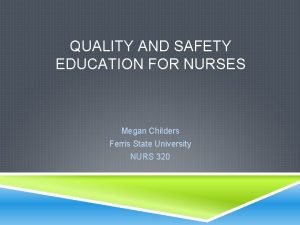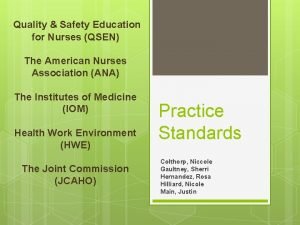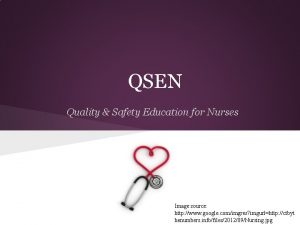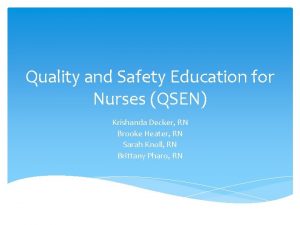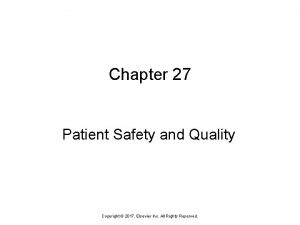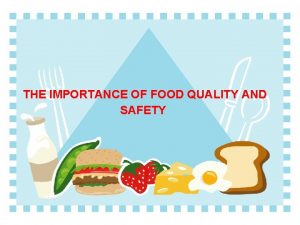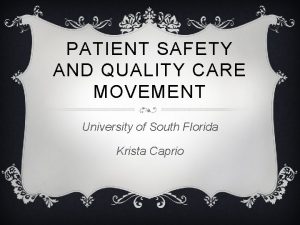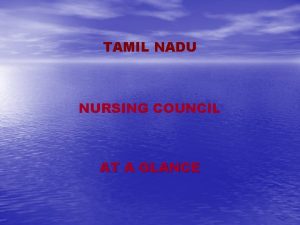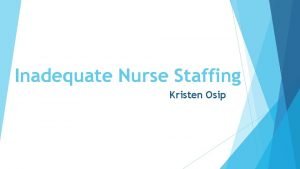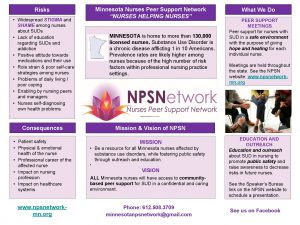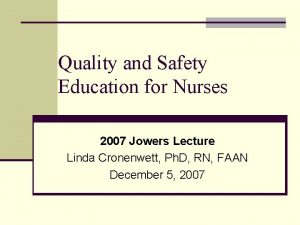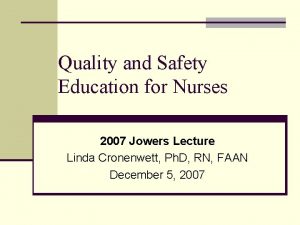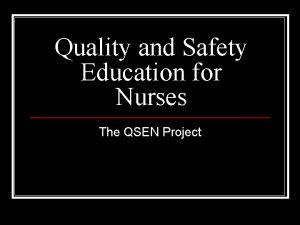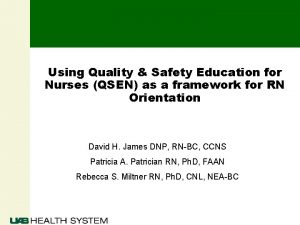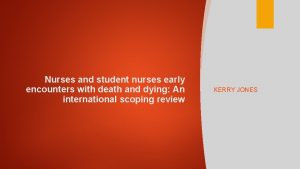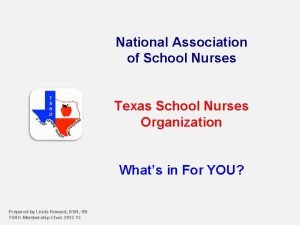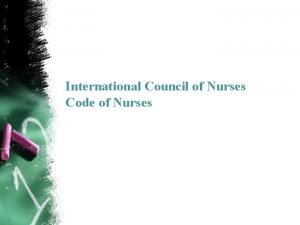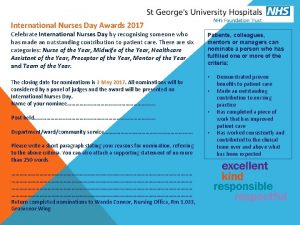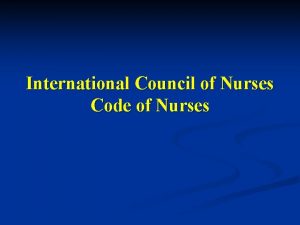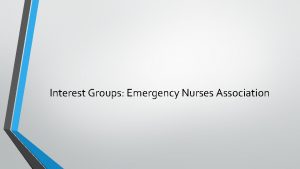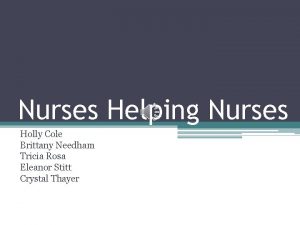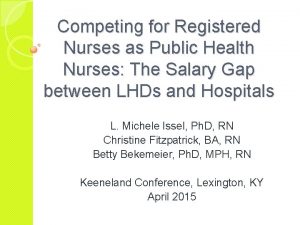Quality and Safety Education for Nurses Group 11
























- Slides: 24

Quality and Safety Education for Nurses Group 11 Ashley Borowiak Wendy Debruyn Hilary Edmondson Kristina Pritchard Kimberly Thompson Adrianne Tozer Ferris State University

What is QSEN? According to www. qsen. org QSEN stands for Quality and Safety Education for Nurses. QSEN is centered around six core competencies related to nursing care. They are: 1. Patient-Centered Care 2. Teamwork and Collaboration 3. Evidence-Based Practice 4. Quality Improvement 5. Safety

The Goal of the QSEN "The overall goal for Quality and Safety Education for Nurses (QSEN) project is to meet the challenge of preparing future nurses who will have the knowledge, skills and attitudes (KSA's) necessary to continuously improve the quality and safety of the health care systems within which they work" (Quality and Safety Education for Nurses, 2012). • This goal is attainable by preparing nursing students with the most up to date quality standards of care. Also

History of QSEN The Robert Wood Johnson Foundation funded the QSEN project starting October 2005. This was considered Phase 1. April 2007 started Phase 2. It aimed to guide nursing toward a commitment to quality and safety competencies in alignment with the (IOM) Institute of Medicine (Quality and Safety Education for Nurses, 2012). Phase 3 occurred in February 2009. This phase was a progression of the previous two. It was about promoting the six core competencies (Quality

History of QSEN continued The most recent press release from the QSEN was in June 2012. This release talked about how Dr. Cronenwett and her colleagues have made it possible that this generation of nurses are able to give quality care and continue to expand on patient quality and safety (Quality and Safety Education for Nurses, 2012). Annual forums are held for educators to gather and share

How is QSEN Funded? QSEN is funded by the Robert Wood Johnson Foundation (RWJF). What is the RWJF? The foundation was created by Robert Wood Johnson in 1972. Robert Wood Johnson was the owner- of JOhnson & Johnson, the world re-owned Company. Robert Wood Johnson had a deep passion to improve the health and the health care of the country. RWJF mission statement: "Our mission is to improve the health and health care of all americans. Our goal is clear: To help our society transform itself for the better. " (Robert Wood Johnson, 2012)

RWJF has funded many of the nation's health care issues facing our country. A few examples of the issues funded: • • 1992 clinics in schools: Making the grade state and local partnerships to establish shool based health centers 1992 tobacco policy, research and evaluation program 1994 Strengthening advanced nursing education 1997 Teen pregnancy A national campaign to prevent teen pregnancy These are just a few examples of ways the RWJF has helped improve the health of our nation. Visit www. rwjf. org to view the full history and timeline of events.

QSEN Funds RWJF funded QSEN starting in 2005. QSEN was funded in three phases. PHASE I RWJF funds a 590, 000 grant to the university of Carolina, at Chapel Hill School of Nursing. THe funds were to be used on nursing students and to increase the knowledge and education of patient safety and health care quality.

Funding continued. . . Phase II RWJF gives 1, 094, 477 to Linda Cronenwell. Linda is a principal investigator. Phase II focuses on the advance practice nurse. It focuses on 15 pilot schools and how they are incorporating changes in the schools education to focus on quality and safety competencies. Phase III RWJF funds two institutions with 4. 25 million dollars. The two institutions are American Association of Colleges of Nursing (AACN) and the university of North Carolina. The third phase focuses on projects that will be used to continue to improve the quality and safety of the places of employment in the healthcare setting.

Quality/Safety Competencies There are six competencies that the QSEN faculty have developed and defined for pre-licensure and graduate nurses. These six quality and safety competencies are: • • • Patient-Centered Care Teamwork & Collaboration Evidence-Based Practice Quality Improvement Safety Informatics

Quality/Safety Competencies The purpose of incorporating the six competencies into QSEN's teaching strategies is to ensure well-developed future nursing graduates. It is essential during our nursing training to understand that the patient is the focus and the one in control. Teaching mutual respect and shared decision making is an important part of teamwork in nursing. Integrating the best current evidence and monitoring data to continuously improve health care vital parts in developing as a nurse. An important component of nursing that also must be taught is about safety and how to reduce the risk of harm to our patients. Another competency that is important in teaching graduate nurses is the use of technology and especially the changes with the electronic health data.

Patient-Centered Care According to QSEN, the definition of patient-centered care is, "Recognize the patient or designee as the source of control and full partner in providing compassionate and coordinated care based on respect for patient's preferences, values, and needs"(Quality & Safety Education for Nurses, 2012). • • Understand the patient is a multi-faceted person Actively involve the patient and family Respect values, attitudes, preferences, cultures and ethnicity Assess and implement plans to alleviate emotional and physical pain. Know the patients expectations Provide education and encourage independence Establish boundaries between nurse and patient Understand ethical and legal issues

QSEN Evidence Based Practice When it comes to evidence based practice, this is a QSEN statement: "Integrate best current evidence with clinical expertise and patient/family preferences and values for delivery of optimal health care. " (Quality and Safety Education for Nurses, 2012). This is a key point in making sure that we always do what is best for our patients. It uses evidence to back the decisions made in how we care for our patients.

Teamwork and Collaboration Teamwork and collaboration is defined as, "Function effectively within nursing and inter-professional teams, fostering open communication, mutual respect, and shared decision-making to achieve quality patient care" (QSEN, 2012). Understand individual strengths and boundaries Make self improvements Contribute and collaborate with the healthcare team Understand scopes of practice Resolve conflict Reduce risks through effective communication Value differences and opinions in others • •

QSEN Quality Improvement Here we find the QSEN position on Quality Improvement: "Use data to monitor the outcomes of care processes and use improvement methods to design and test changes to continuously improve the quality and safety of health care systems. " (Quality and Safety Education for Nurses, 2012). By continuously monitoring patient outcomes, we are able to ensure that we are doing is the right thing, and that we are achieving the expected outcomes. In the cases, where we are not achieving the desired outcomes, we are able to find the breakdown in the system and fix it.

Safety is a quality and safety competency because it "Minimizes risk of harm to patients and providers through both system effectiveness and individual performance, " (QSEN, 2012). Safety can be ensured and practiced by performing the following: • • • Reduce harm of self or others by demonstrating effective use of strategies. Reducing reliance on memory to decrease errors. Use effective communication to report concerns related to hazards and errors to patients, families and the health care team. Report near misses and errors using an error reporting system. Take self responsibility for errors rather than pointing the blame when near misses or errors occur. Utilize national patient safety resources for personal and facility development.

Informatics According to the QSEN (2012), informatics is the use information and technology to communicate, manage knowledge, mitigate error, and support decision making of the members of a health care team. Effective informatics is demonstrated by the following: • • • Seeking education regarding how information is managed before implementing care. Applying technology and information management systems to support safe implementation of care. Using a documentation system to document all paient care and activities in the electronic medical record. Monitoring outcomes of care processes using information management tools. Using high quality electronic systems to document care.

How QSEN Relates To My Nursing Practice As a nurse on a medical/surgical floor, QSEN reflects my nursing practice as Sparrow Clinton Hospital by providing individualized care that encompasses all aspects of the patient. Through shared decision making, education and teamwork, we are able to offer safe, high quality nursing care to every patient. • • • Education inservices, skills fair, continuing education Safety protocols and committees Healthcare team conferences Patient teaching and education Ethics committee Shared decision making between patient and healthcare team

How QSEN Relates To My Nursing Practice In my current practice area of the Emergency Department at Spectrum Health United Campus, QSEN is reflected in all of my patients care. This is accomplished by the following: • • • Detailed patient discharge instructions with education regarding diagnosis and follow up care. Time given for patient and other participants to clarify questions or concerns. Two patient identifiers and other safety measures used at all times while caring for the patient. Ability to work as a team and in collaboration with others such as radiology, lab staff, physicians, and other nurses to ensure that the patient receives the highest quality of care possible. Ensuring to take time to listen to patient and family concerns when they arise ensuring patient-centered care. Performing continuing education in order to stay current with the latest evidence-based practices. This is completed by utilizing Skills day and Growing Up with Us CEU's provided by SHUM each month. Wendy De. Bruyn

How QSEN Relates To My Nursing Practice In my current practice as a Registered Nurse in Interventional Radiology at Spectrum Health, QSEN practice standards influence my nursing practice with every patient I care for and in every situation. "QSEN is a national initiative to identify the competencies, knowledge, skills, and attitudes needed by all nurses to continuously improve the Quality and Safety of healthcare. " (Disch, 2012) Spectrum Health focuses and educates staff daily on patient safety. Spectrum Health also requires all of their nurses to complete yearly competencies, mandatory education, and also to complete/keep certifications up to date.

How QSEN Relates to My Nursing Practice In my current speciality area of obstetrics, QSEN standards influence my nursing practice by ensuring high quality patient-centered care. At West Shore Medical Center (WSMC), where I am employed at as a registered nurse, our guiding principle is, "Our costumers are the center of everything we do" (WSMC, 2012). The department that I am a part of takes great pride in our patient satisfaction scores and have been recognized in being at the top nationally for several years. Our mission is to provide excellent care to our patients by actively involving the patient and their family during their stay, knowing the patient's expectations, and providing education that is individualized to each specific patient. As we introduce ourselves to our patients, we inform them that our goal is to provide them with excellent care and to let us know what we can do to improve their stay. Hilary Edmondson

How QSEN Impacts My Nursing Practice QSEN standards of Evidence Based Practice and Quality Improvement impact my daily practice in helping me to provide the best possible care to every patient, every time. These standards are what guide me in everything that I do for every patient. The evidence ensures that the procedures I perform in practice are done in the safest possible manner. The facility that I work for has an entire department devoted to quality improvement, in order to ensure that we have the best possible outcomes for every patient, every time. This department also sends all nurses alerts when new EBPs are issued, and ensures that facility wide policies and procedures are updated to reflect the best practice.

How QSEN Impacts My Nursing Practice Working in the Medical/Surgical and Intensive Care Units at Otsego Memorial Hospital (OMH), different policy and procedures exist between each department. The hospital's quality improvement department is continuously editing policies and procedures to conform them to meet national standards, such as QSEN. In addition to updating hospital wide and department policies, OMH also performs the following: Forms committees such as CAUTI Prevention, Medication Errors and Near Miss Prevention, Suggestion and Implemtation and Bowel and Bladder Protocol. Recently finished the final aspect of the transition to a stricly electronic system, including documentation, bedside medication verification and physician order entry. Within the last year, has implemented using Nite. Watch pharmacy to process medication orders and drug dosing when the hospital pharmacy is not available. This uses QSEN practices to decrease medication errors and nears misses.

References Disc, J. (2012) QSEN? What's QSEN? Nursing outlook, 60(2), 58 -59, doi: 10. 10161 j. outlook. 2012. 01. 001 Quality & Safety Education for Nurses (QSEN). (2012). Quality and safety competencies. Retrieved from http: //www. qsen. org/competencies. php) Robert Wood Johnson Foundation (RWJF). (2012). Retrieved from http: //www. rwjf. org West Shore Medical Center (2012). Mission, Vision, & Values. Retrieved from http: //www. westshoremedcenter. org/about/value-vision.
 Quality and safety education for nurses
Quality and safety education for nurses Quality and safety education for nurses
Quality and safety education for nurses Qsen phases
Qsen phases Quality and safety education for nurses (qsen)
Quality and safety education for nurses (qsen) Quality assurance vs quality control
Quality assurance vs quality control Quality control basics
Quality control basics A nurse floats to a busy surgical unit
A nurse floats to a busy surgical unit Safety quality productivity
Safety quality productivity Samantha taylor ndis commission
Samantha taylor ndis commission Importance of food quality
Importance of food quality Patient safety and quality care movement
Patient safety and quality care movement Blood safety and quality regulations
Blood safety and quality regulations Tnnmc website
Tnnmc website Safe staffing ratios benefiting nurses and patients
Safe staffing ratios benefiting nurses and patients Eagle plains public school
Eagle plains public school Quality control vs quality assurance pmp
Quality control vs quality assurance pmp Pmp gold plating
Pmp gold plating Quality assurance cycle in nursing
Quality assurance cycle in nursing Quality improvement vs quality assurance
Quality improvement vs quality assurance Known as the fun uncle of the quality revolution
Known as the fun uncle of the quality revolution Crosby quality is free
Crosby quality is free Old quality vs new quality
Old quality vs new quality Formuö
Formuö Typiska novell drag
Typiska novell drag Nationell inriktning för artificiell intelligens
Nationell inriktning för artificiell intelligens
